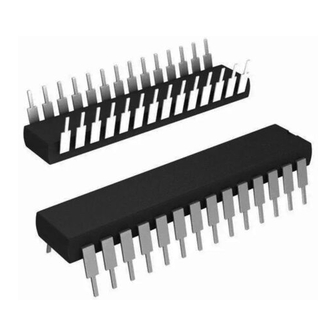Table of Contents
Advertisement
Features
•
High Performance, Low Power AVR
•
Advanced RISC Architecture
– 131 Powerful Instructions – Most Single Clock Cycle Execution
– 32 x 8 General Purpose Working Registers
– Fully Static Operation
– Up to 20 MIPS Throughput at 20 MHz
– On-chip 2-cycle Multiplier
•
High Endurance Non-volatile Memory Segments
– 4/8/16/32K Bytes of In-System Self-Programmable Flash progam memory
(ATmega48P/88P/168P/328P)
– 256/512/512/1K Bytes EEPROM (ATmega48P/88P/168P/328P)
– 512/1K/1K/2K Bytes Internal SRAM (ATmega48P/88P/168P/328P)
– Write/Erase Cycles: 10,000 Flash/100,000 EEPROM
– Data retention: 20 years at 85°C/100 years at 25°C
– Optional Boot Code Section with Independent Lock Bits
In-System Programming by On-chip Boot Program
True Read-While-Write Operation
– Programming Lock for Software Security
•
Peripheral Features
– Two 8-bit Timer/Counters with Separate Prescaler and Compare Mode
– One 16-bit Timer/Counter with Separate Prescaler, Compare Mode, and Capture
Mode
– Real Time Counter with Separate Oscillator
– Six PWM Channels
– 8-channel 10-bit ADC in TQFP and QFN/MLF package
Temperature Measurement
– 6-channel 10-bit ADC in PDIP Package
Temperature Measurement
– Programmable Serial USART
– Master/Slave SPI Serial Interface
– Byte-oriented 2-wire Serial Interface (Philips I
– Programmable Watchdog Timer with Separate On-chip Oscillator
– On-chip Analog Comparator
– Interrupt and Wake-up on Pin Change
•
Special Microcontroller Features
– Power-on Reset and Programmable Brown-out Detection
– Internal Calibrated Oscillator
– External and Internal Interrupt Sources
– Six Sleep Modes: Idle, ADC Noise Reduction, Power-save, Power-down, Standby,
and Extended Standby
•
I/O and Packages
– 23 Programmable I/O Lines
– 28-pin PDIP, 32-lead TQFP, 28-pad QFN/MLF and 32-pad QFN/MLF
•
Operating Voltage:
– 1.8 - 5.5V for ATmega48P/88P/168PV
– 2.7 - 5.5V for ATmega48P/88P/168P
– 1.8 - 5.5V for ATmega328P
•
Temperature Range:
°
°
– -40
C to 85
C
•
Speed Grade:
– ATmega48P/88P/168PV: 0 - 4 MHz @ 1.8 - 5.5V, 0 - 10 MHz @ 2.7 - 5.5V
– ATmega48P/88P/168P: 0 - 10 MHz @ 2.7 - 5.5V, 0 - 20 MHz @ 4.5 - 5.5V
– ATmega328P: 0 - 4 MHz @ 1.8 - 5.5V, 0 - 10 MHz @ 2.7 - 5.5V, 0 - 20 MHz @ 4.5 - 5.5V
•
Low Power Consumption at 1 MHz, 1.8V, 25°C for ATmega48P/88P/168P:
– Active Mode: 0.3 mA
– Power-down Mode: 0.1 µA
– Power-save Mode: 0.8 µA (Including 32 kHz RTC)
Note:
1. See
"Data Retention" on page 7
®
8-Bit Microcontroller
(1)
2
C compatible)
for details.
8-bit
Microcontroller
with 4/8/16/32K
Bytes In-System
Programmable
Flash
ATmega48P/V*
ATmega88P/V*
ATmega168P/V
ATmega328P**
**Preliminary
*
Not recommended for new designs.
Rev. 8025I–AVR–02/09
Advertisement
Table of Contents















Need help?
Do you have a question about the ATmega48PV and is the answer not in the manual?
Questions and answers